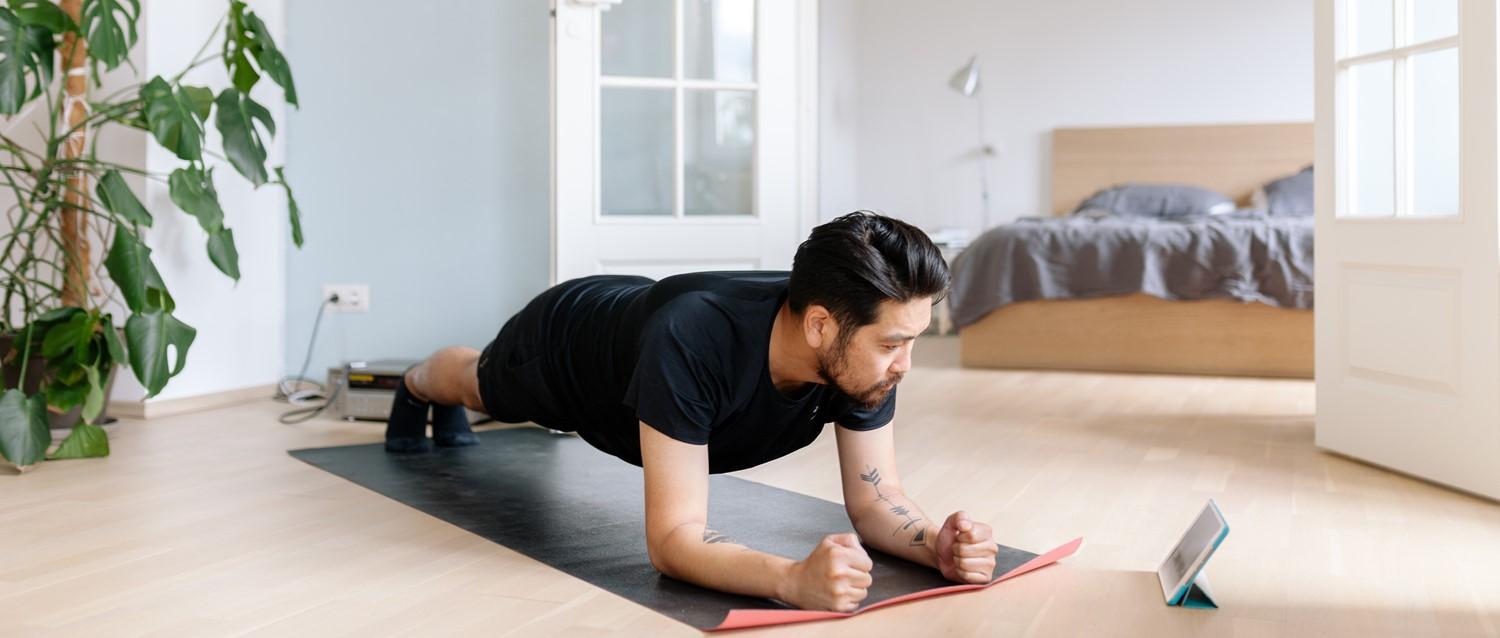
COVID-19 coronavirus: how to exercise at home
Peer reviewed by Dr Sarah Jarvis MBE, FRCGPLast updated by Abi MillarLast updated 24 Mar 2020
- DownloadDownload
- Share
The government have announced new measures to contain the spread of coronavirus which include telling people to only leave their house for exercise once a day. With gyms closed and events cancelled, many of us will be exercising at home in the coming weeks.
In this article:
If you're currently stuck at home, you may be feeling demoralised about what this will mean for your fitness. Whether you were training for a marathon (which has subsequently been cancelled) or enjoy working out at the gym (which has been closed until further notice), it can be tough to think of putting your usual routine on hold.
Even if you're not much of a fitness fan, you may baulk at the prospect of staying indoors for a few weeks while barely raising your step count. Exercise is vital for our mental and physical health, and is arguably more important than ever during periods of self-isolation.
The bad news is that, under new measures announced by the UK Government, leaving your house is only permitted for essential reasons. The good news is that doesn't mean stopping activity altogether. You're still able to go outside once per day for exercise. And it's possible to use this time to get fitter and stronger than ever, albeit while adapting your workout so that it can be done from home.
"It's definitely possible to stay fit at home, particularly through intense workouts that tend to work better for fat loss and muscle growth in comparison to long-duration cardio," says Chloe Twist, a personal trainer at OriGym. "Add kettlebells or a set of dumbbells into the mix, and this will ensure that you're doing enough strength training to maintain and build lean muscle away from the gym."
Continue reading below
Body weight training
One of the most effective workouts, if you can't leave the house, is a mix of body-weight exercises and high-intensity interval training (HIIT). Body-weight HIIT workouts are relatively short and don't take up much space. Best of all, they don't require any equipment.
If you:
Have underlying health problems; or
Currently have a very sedentary lifestyle and any risk factors for heart disease (such as high blood pressure).
HIIT may not be safe for you. Read on for alternatives you can try.
"As the name suggests, body-weight training uses your body as resistance to give you a challenging workout, which can improve your fitness levels and also build strength," explains David Wiener, a training specialist at Freeletics. "Relying on only your body to work out also improves balance and flexibility, engaging and targeting all of the important muscle groups with just a few exercises like squats, planks and burpees."
There are plenty of suitable workouts available online. Freeletics, which describes itself as a 'personal trainer in your pocket', builds customised body-weight-only exercises that are tailored to your goals and ability. Jennis, a new fitness app from Olympic champion Dame Jessica Ennis-Hill, offers HIIT-style workouts that are less than half an hour long. You could also download a Tabata app or Sweat Deck to guide you and time your sequences.
"Interval training can be a great way to maintain fitness, and you don't need much space. Hill sprints, jump squats, burpees, skipping or fast push-ups will have you sweating in no time," says Vicki Anstey, founder of Barreworks.co.uk.
Patient picks for Exercise and physical activity
High-tech options
If you're lucky enough to have access to some high-tech equipment, now's the time to take full advantage. You might want to try a video game like BoxVR - a boxing-inspired workout that places you in a virtual gym. Or, if you have a treadmill or exercise bike, virtual reality app Zwift will gamify your indoor training session, making it vastly more fun.
For those who have the money and the space, it's possible to set up a small home gym with only a few key pieces of equipment.
"Things like a rack and adjustable bench, along with some barbells, dumbbells and weight plates, are incredibly versatile," says Elliott Upton, head of LiveUP Online Coaching at Ultimate Performance. "You can do infinite variations of squats, deadlifts, pushes, presses and rows with these. The same can be said for the dual adjustable cable pulley machine. There's pretty much nothing you can't do with that."
Continue reading below
Low-impact exercise
If you prefer something lower-impact (or don't want to disturb the neighbours), now's the time to roll out a mat or towel and try some yoga or Pilates. You could also opt for a 'non-aggressive, high burn' workout like the GS Method, or a functional body-weight workout like Animal Flow.
"Just because you're at home doesn't mean you can't access a plethora of yoga videos, fitness routines and meditations," says personal trainer Roxy Danae. "Walking meditations are ideal and can be done in your house. Put your earphones in, concentrate on your chosen guided meditation and get your steps in whilst you do it."
If you're feeling sad about having to miss your usual class, it's worth checking in with your favourite teacher or studio, to see if they're continuing their scheduling online. To cite just one example, MoreYoga, London’s largest independent yoga studio chain, has started offering free classes on its YouTube channel (as well as additional classes for members). The idea is to maintain connection and community during this time of social distancing.
Staying motivated
Of course, even with the best of intentions, you may find your motivation flagging from time to time. You probably just want things to go back to normal, rather than trying to clear a patch of space in your living room for the thirteenth day in a row.
Setting goals
For this reason, it's important to set goals, big and small, and to schedule your workouts. Routine is important here. Elliott Upton advises planning your workouts for first thing in the morning, so you can get them out the way before the day's distractions kick in, while Vicki Anstey suggests setting an alarm for two-hour intervals.
"Set yourself a 20-minute movement session three times a day - this will help break the day up and make limited resources go further!" she says. "Go up and down the stairs, use a box or ledge to perform step-ups, etc."
Maintaining fitness
She adds that it takes about seven to 14 days for your aerobic fitness to start declining. This means taking a few weeks out of your running schedule, for instance, won't have much long-term effect.
"What you lose initially is mostly the gains that you've made in the last several months of training," she says. "If you've been a lifelong runner, you will retain much of your aerobic fitness for several months."
Chloe Twist suggests that, if you're anxious about losing fitness, it might be worth tracking your progress in a fitness journal or fitness app. Some apps have the added advantage of a virtual community, who can hold you accountable and keep you on track.
"A fitness app will give you solid evidence to refer back to when you're doubting your progress, and you won't succumb to negative thoughts that could prevent you from exercising altogether," she says.
Positive thinking
Finally, if ever there was a time to apply the power of positive thinking, this is it. David Wiener suggests reframing the situation - seeing it less as a blow to your fitness, and more as a chance to switch things up and progress.
"Don't be disheartened if you can't continue with your current fitness regime, or a race or event that you've been training for has been cancelled," he says. "In this day and age there are tons of options and resources to work out from home, so rather than taking a negative view of the situation when it comes to maintaining your fitness levels, see it as a motivating challenge and a chance to switch things up and progress."
Article history
The information on this page is peer reviewed by qualified clinicians.
24 Mar 2020 | Latest version

Ask, share, connect.
Browse discussions, ask questions, and share experiences across hundreds of health topics.

Feeling unwell?
Assess your symptoms online for free
